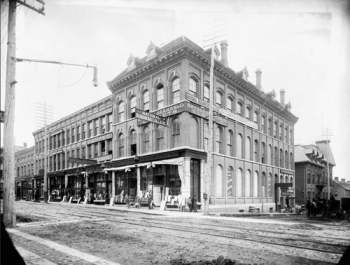6 September 1870
Sparks Street used to be the beating heart of Ottawa commerce, home to several major local department stores that had their roots in the late nineteenth century. These included L. N. Poulin’s Dry Goods store, R.J. Devlin & Company, Murphy-Gamble, and Bryson, Graham Ltd. One by one they disappeared into history. Most were bought out by larger chain stores before they too succumbed as shoppers flocked to exciting new suburban shopping centres with ample parking facilities that were closer to where people lived. But back during the early twentieth century when Sparks Street was at its zenith, the place to shop was Bryson, Graham Ltd, then known as “Ottawa’s Greatest Store.”
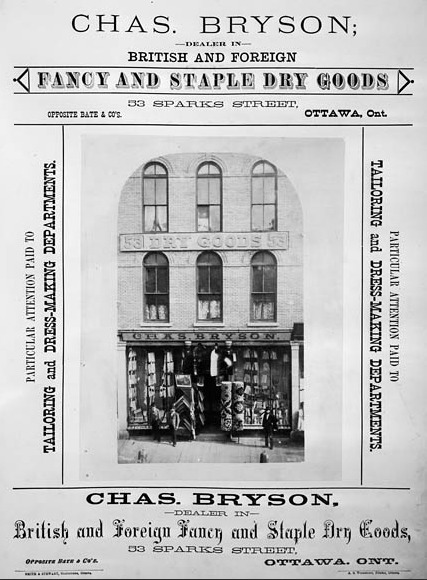 Charles Bryson’s Dry Goods Store, 53 Sparks Street, 1875, William James Topley, Library and Archives Canada, PA-002237.It opened for business on 6 September 1870 as Patterson & Bryson at 53 Sparks Street on the south side of the Street (later renumbered as 110 Sparks Street). The firm was named after its two principals, Joseph H. Patterson and Charles B. Bryson. Initially, there wasn’t much going for the modest dry-goods business. With the main commercial streets in Ottawa at that time being Rideau, Sussex and Wellington, the store had an unpromising location. Business was tough during those early years. Indeed, in 1873, the partnership ended, with Patterson decamping to New York City to establish a dry goods business there. Bryson, a country boy from Richmond who had come to Ottawa in 1864 and learnt the dry-good business working at the firm T. Hunt & Sons, soldiered on alone. The split-up appeared to have been relatively amicable, or at least any hard feelings healed over time. On the firm’s silver anniversary in 1895, Patterson sent Bryson from New York a souvenir of their first day in business. Concealed inside twenty-five nested envelopes was the first 5-cent piece the store took in. On one side was engraved “P & B” with “6th Sept., 1870” inscribed on the other.
Charles Bryson’s Dry Goods Store, 53 Sparks Street, 1875, William James Topley, Library and Archives Canada, PA-002237.It opened for business on 6 September 1870 as Patterson & Bryson at 53 Sparks Street on the south side of the Street (later renumbered as 110 Sparks Street). The firm was named after its two principals, Joseph H. Patterson and Charles B. Bryson. Initially, there wasn’t much going for the modest dry-goods business. With the main commercial streets in Ottawa at that time being Rideau, Sussex and Wellington, the store had an unpromising location. Business was tough during those early years. Indeed, in 1873, the partnership ended, with Patterson decamping to New York City to establish a dry goods business there. Bryson, a country boy from Richmond who had come to Ottawa in 1864 and learnt the dry-good business working at the firm T. Hunt & Sons, soldiered on alone. The split-up appeared to have been relatively amicable, or at least any hard feelings healed over time. On the firm’s silver anniversary in 1895, Patterson sent Bryson from New York a souvenir of their first day in business. Concealed inside twenty-five nested envelopes was the first 5-cent piece the store took in. On one side was engraved “P & B” with “6th Sept., 1870” inscribed on the other.
Things began to pick up in the 1880s after Bryson welcomed Frederick Graham into the business which by this point had moved to 152 Sparks Street. Like his colleague, Graham was a country boy. He had come to Ottawa to sell agricultural equipment for William Arnold on Wellington Street. Dissatisfied with his career choice, he joined Bryson in 1880 and very quickly proved his worth. After only a year, he was offered a piece of the business and became a junior partner. Bryson, Graham & Company was born. It was a partnership that was to last close to fifty years. Bryson took charge of the management of the company while Graham took responsibility for buying. In 1882, Graham became part of the family as well, marrying Miss Margaret Bryson, Charles Bryson’s sister.
During the early 1880s, the duo introduced a radical innovation to Ottawa—“One Price for All.” Hitherto, Ottawa residents haggled with merchants for all their purchases, a process that wasted valuable time and typically left somebody dissatisfied. At the same time, Bryson and Graham advertised “Maximum Value for the Money.” Initially, this novel approach to selling cost the partners business, but the general public quickly caught on.
In one possibly apocryphal story set sometime in the 1880s, ten lumbermen entered Bryson Graham to purchase their gear for the coming logging season. They picked out goods worth $650, a very large sum back in those days. The foreman offered to pay $600. The salesman refused. The foreman then asked if he would throw in a vest for each of the workers. Again, the salesman refused. A pair of braces? Again, the answer was no. The group left the store in a huff, repairing to “The Brunswick” for a drink. They later came back, their leader indicating that they would pay the $650 if the salesman threw in a collar button for each of the men. Again, the salesman refused. When called over, Bryson backed up his salesman and explained the store’s pricing policy to the lumbermen. Giving up and paying the full amount, the foreman admitted that he had bet $10 that he could beat down the store. He added that “it was worth more than $10 to find there is one honest price store in Ottawa.”
The reputation of Bryson and Graham for integrity and straight dealing was the backbone of their company. Over the next fifty years, the company prospered mightily. In 1883, the company expanded eastward, leasing the adjoining store. In 1887, the firm added home furnishings when it acquired the stock and premises of Shouldbred & Company, followed by the acquisition of the stock of dress-goods and silks from Mr John Garland. In 1890, John Bryson, the brother of Charles opened a grocery store in the Bryson-Graham premises. This business was later formally consolidated into the family enterprise. This was a gutsy step. The grocery business in Ottawa had previously been an albatross for other department stores. In 1892, the firm bought the china and crockery business of Mr Sam Ashfield in the neighbouring store. Two years later, the company expanded yet again and acquired the entire block when it took over the corset business of yet another neighbour, Mrs Scott. On their silver anniversary in 1895, the firm built a factory extension to Queen Street.
To mark twenty-five years of progress and expansion, the store’s staff gave Charles Bryson a gold-mounted ebony cane. They also presented a testimonial to their boss reading “…under your control, we are happy to labour, and hope that our constant efforts and devotion to business will meet with your appreciation. With great pleasure do we take this opportunity to congratulate you on your past success, and to say that we are proud to see your business house classed amongst the most important and successful houses of the Dominion.”
Innovations and expansion continued during the store’s second twenty-five years. In 1898, Bryson, Graham & Company was the first in Ottawa to use the “comptometer,” the first successful, key-driven, calculating machine. It was used for adding and calculating work, sales checks, statements and invoicing. In 1909, the partnership was transformed into a limited liability company. Two years later, the company erected a large warehouse on Queen Street to store its extensive inventory.
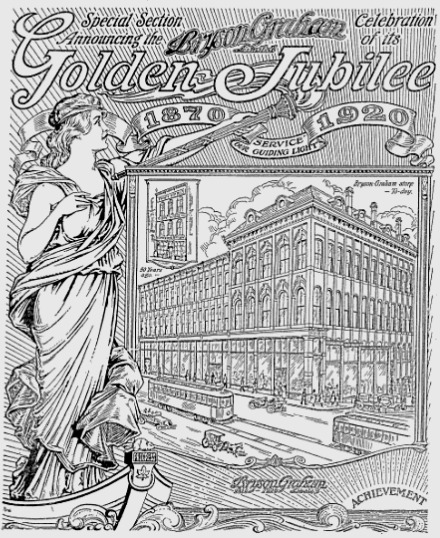 Cover to the Special Supplement in Celebration of Bryson-Graham’s Golden Anniversary, The Ottawa Citizen, 28 February 1920.In 1917, the long and successful partnership of Charles Bryson and Frederick Graham came to an end with the former’s death. Graham became the company’s president, with Mr James B. Bryson, the son of Charles, as vice-president. In 1920, the Ottawa Citizen newspaper celebrated the golden anniversary of the company with a supplement dedicated exclusively to the department store, its history, and its successes. The newspaper opined that the secret of the retailer’s success was the character of Charles Bryson—“his untiring efforts, his forceful personality and his integrity.” The paper also re-published his obituary that stated that Bryson “was a gentleman in business as in his private life; a kind employer, a devoted friend, a real Christian.” The newspaper stated that the many friends of “Ottawa’s Greatest Store” hoped that “the next fifty years will witness an expansion proportionate to that of those gone by.”
Cover to the Special Supplement in Celebration of Bryson-Graham’s Golden Anniversary, The Ottawa Citizen, 28 February 1920.In 1917, the long and successful partnership of Charles Bryson and Frederick Graham came to an end with the former’s death. Graham became the company’s president, with Mr James B. Bryson, the son of Charles, as vice-president. In 1920, the Ottawa Citizen newspaper celebrated the golden anniversary of the company with a supplement dedicated exclusively to the department store, its history, and its successes. The newspaper opined that the secret of the retailer’s success was the character of Charles Bryson—“his untiring efforts, his forceful personality and his integrity.” The paper also re-published his obituary that stated that Bryson “was a gentleman in business as in his private life; a kind employer, a devoted friend, a real Christian.” The newspaper stated that the many friends of “Ottawa’s Greatest Store” hoped that “the next fifty years will witness an expansion proportionate to that of those gone by.”
This wish was not granted. Three years later, in 1923, Frederick Graham died, and the venerable company on Sparks Street passed fully into the hands of the next generation of Brysons and Grahams. James Bryson took over as president and W.M. Graham stepped into the vice-president’s position. For a time, Bryson-Graham continued to do well, but its years of expansion were over. It had apparently transitioned into a comfortable middle age. While it continued to provide a wide range of quality goods to Ottawa customers at reasonable prices, the drive and determination of its founders were gone.
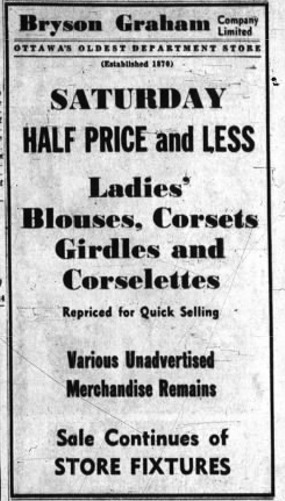 Bryson-Graham’s Last Advertisement, The Ottawa Journal, 17 April 1953Business suffered through the lean years of the Depression and World War II. By the late 1940s, the company was dowdy and old fashioned. In May 1950, Ormie A. Awrey, who had been vice-president and general manager of the firm for the previous eleven years acquired control of the business from the children of the late Charles Bryson and Frederick Graham, buying 85 per cent of the company for $1 million. He later bought the remaining shares. Awrey promised to carry on the traditions of the old firm, but the retailer continued to decline. Parts of the old building were rented out to other retailers, including Bata Shoes, Swears and Wells, and Dolcis. In February 1953, he sold the Bryson-Graham block in February 1953 to J. B. and Archie Dover of Dover’s Ltd for only $310,000. After holding a clearance sale of its stock and fittings, Bryson-Graham, now billed as “Ottawa’s Oldest Department Store,” closed for good on 18 April 1953, ending an 83-year presence on Sparks Street.
Bryson-Graham’s Last Advertisement, The Ottawa Journal, 17 April 1953Business suffered through the lean years of the Depression and World War II. By the late 1940s, the company was dowdy and old fashioned. In May 1950, Ormie A. Awrey, who had been vice-president and general manager of the firm for the previous eleven years acquired control of the business from the children of the late Charles Bryson and Frederick Graham, buying 85 per cent of the company for $1 million. He later bought the remaining shares. Awrey promised to carry on the traditions of the old firm, but the retailer continued to decline. Parts of the old building were rented out to other retailers, including Bata Shoes, Swears and Wells, and Dolcis. In February 1953, he sold the Bryson-Graham block in February 1953 to J. B. and Archie Dover of Dover’s Ltd for only $310,000. After holding a clearance sale of its stock and fittings, Bryson-Graham, now billed as “Ottawa’s Oldest Department Store,” closed for good on 18 April 1953, ending an 83-year presence on Sparks Street.
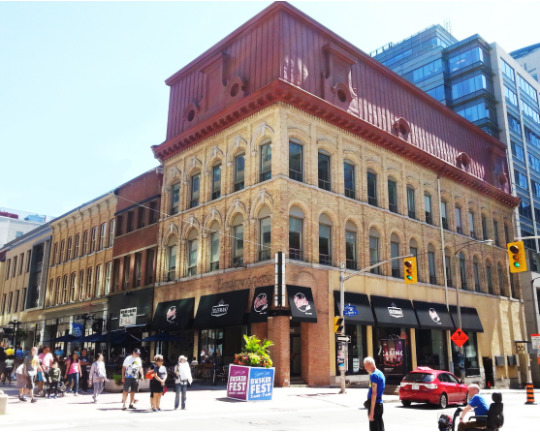 The Bryson-Graham building today, corner of Sparks and O’Connor Streets, July 2017, Nicolle Powell
The Bryson-Graham building today, corner of Sparks and O’Connor Streets, July 2017, Nicolle Powell
Today, the Bryson-Graham building at the corner of Sparks and O’Connor Streets still stands. The ground floor is occupied by Nate’s Delicatessen.
Sources:
Elder, Ken, 2009. Bryson, Graham & Co., Ottawa Canada, http://www.eeldersite.com/Bryson-_Graham_-_Co.pdf.
Ottawa Citizen (The), 1920. “Bryson-Graham Ltd Celebrates Its Golden Jubilee, 28 February.
————————-, 1920. “Silver Anniversary of Store,” 28 February.
————————-, 1920. “Character of Founder Largely Responsible For Store’s Success,” 28 February.
————————-, 1920. “Battery of Comptometers Used in Bryson-Graham’s Stores,” 28 February.
————————-, 1920. “Hard Work One Secret Of The Success Won By Messrs. Bryson-Graham,” 28 February.
————————-, 1920. “One-Price Policy Was Introduced In Ottawa By Bryson-Graham Co.” 28 February.
Ottawa Journal (The), 1895. “A Five Cents With A History,” 10 September.
————————–, 1935. “The Shops of the Capital, What they Were and Are,” 10 December.
————————–, 1950. “O.A. Awrey Acquires Control of Bryson Graham Ltd,” 5 May.
————————–, 1953. “Dovers Buy Bryson Blok,” 12 February.
————————–, 1953. “$10,000, Bryson-Graham Sale Heads May Property Deals,” 4 July.
Urbsite, 2012, Sparks Street Department Stores: Bryson Graham and Company, http://urbsite.blogspot.ca/2012/10/sparks-department-stores-bryson-graham.html.
Story written by James Powell, the author of the blog Today in Ottawa's History.
Retired from the Bank of Canada, James is the author or co-author of three books dealing with some aspect of Canadian history. These comprise: A History of the Canadian Dollar, 2005, Bank of Canada, The Bank of Canada of James Elliott Coyne: Challenges, Confrontation and Change,” 2009, Queen’s University Press, and with Jill Moxley, Faking It! A History of Counterfeiting in Canada, 2013, General Store Publishing House, Renfrew, Ontario. James is a Director of The Historical Society of Ottawa.



